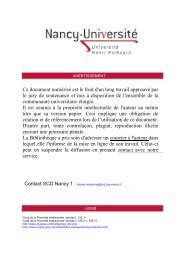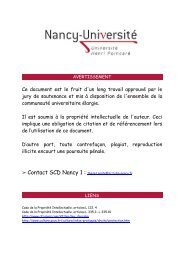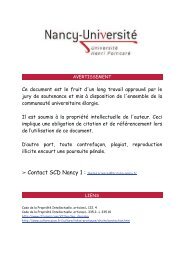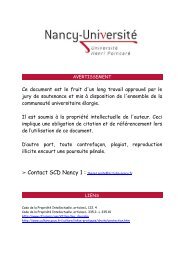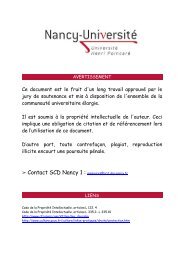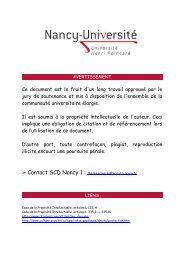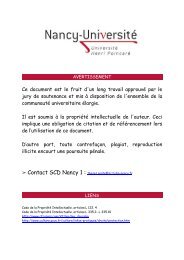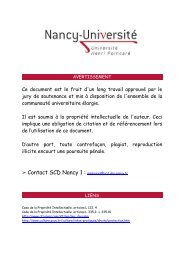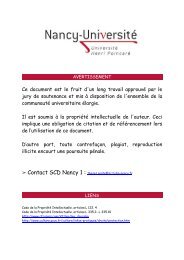Ce document numérisé est le fruit d'un long travail approuvé par le ...
Ce document numérisé est le fruit d'un long travail approuvé par le ...
Ce document numérisé est le fruit d'un long travail approuvé par le ...
You also want an ePaper? Increase the reach of your titles
YUMPU automatically turns print PDFs into web optimized ePapers that Google loves.
PPARs and Human Fetal Dig<strong>est</strong>ive Tract 607<br />
Figure 5 Differentiai expression of<br />
PPARa in developing human fetal dig<strong>est</strong>ive<br />
tract by immunohistochemistry.<br />
(A-C) Transverse esophageal sections<br />
at 7WD (A), 14WD (B), and<br />
20WD (C), showing expression of the<br />
PPAR isotype mainly in the epithelial<br />
cells. (D-F) Gastric sections at 12WD<br />
(D), 15WD (E), and 19WD (F). Expression<br />
of PPARa is detected in the cytoplasm<br />
of the gastric epithelial cells.<br />
(G-L) Small int<strong>est</strong>ine. Expression of<br />
the PPAR subtype is faint in jejunum<br />
(G, 7WD; H, 12WD; l, 16WD) and<br />
higher in i<strong>le</strong>um (J, 12WD; K, 16WD; L,<br />
22WD). The presence of PPAR", is also<br />
detected in the epithelial colon cells<br />
(M-O) at 8WD (M), 14WD (N), and<br />
20WD (0). Bar = 75 f-lm.<br />
staining was observed in the crypt regions. However,<br />
it was barely detected at 14WD (Figure 6N).<br />
PPARy Expression<br />
The different antibodies (anti-PPARy, anti-PPAR')'1/')'2,<br />
and anti-PPAR')'2 antisera) used gave similar results<br />
for their di'stribution throughout the development of<br />
the human fetal dig<strong>est</strong>ive tract. However, the immunoreactivity<br />
was always higher with the anti-PPAR')'2<br />
antibody com<strong>par</strong>ed to that observed with the two<br />
other antibodies. One can expiain this difference by a<br />
higher <strong>le</strong>vel of immunoglobulins in the anti-PPAR')'2<br />
antiserum. Therefore, only results obtained with the<br />
anti-PPAR')'2 antiserum are presented here (Tab<strong>le</strong> 1).<br />
In addition, the presence of mRNA encoding ppAR')'2<br />
was confirmed in int<strong>est</strong>inal extracts from human fetuses<br />
by nuc<strong>le</strong>ase 51 protection assay (Figure 7).<br />
The presence of the PPAR')'2 protein was detected<br />
at 7WD (Figure 8A), 14WD (Figure 8B), and 20WD<br />
(Figure 8C) in esophagus. Throughout human fetal<br />
esophageal development, the staining was moderate or<br />
high and was r<strong>est</strong>ricted to nuc<strong>le</strong>i of both epithelial and<br />
extra-epithelial cells.<br />
Expression of PPAR')'2 was lower in the gastric epithelium<br />
(Figures 8D-8F) than in the esophageal tissue.<br />
A slight increase was noted at 15WD (Figure 8E).<br />
5taining with the anti-PPAR')'2 antibody was <strong>par</strong>ticularly<br />
prominent in epithelial cell nuc<strong>le</strong>i of jejunum<br />
(Figures 8G-8I) and i<strong>le</strong>um (Figures 8J-8L). Because<br />
nuc<strong>le</strong>i were localized in the basal <strong>par</strong>t of epithelial<br />
cells, PPAR')'2 staining showed a spotted distribution<br />
a<strong>long</strong> the basal plasma membrane. Owing to the<br />
abundance of nuc<strong>le</strong>i, the intensity of fluorescence appeared<br />
higher in the crypt regions com<strong>par</strong>ed with the<br />
immunoreactivity in the upper villous regions (Figures<br />
81, 8K, and 8L).<br />
At 8 WD (Figure 8M) and 14WD (Figure 8N),<br />
most nuc<strong>le</strong>i of colon epithelial and mesenchymal cells<br />
were labe<strong>le</strong>d with the anti-PPAR')'2 antibody. At 20WD<br />
the immunoreaction was higher and was more r<strong>est</strong>ricted<br />
to nuc<strong>le</strong>i of specialized cells facing the colon<br />
lumen (Figure 80).<br />
Discussion<br />
The results described here <strong>est</strong>ablish for the first time<br />
the presence and the spatiotemporal distribution of



